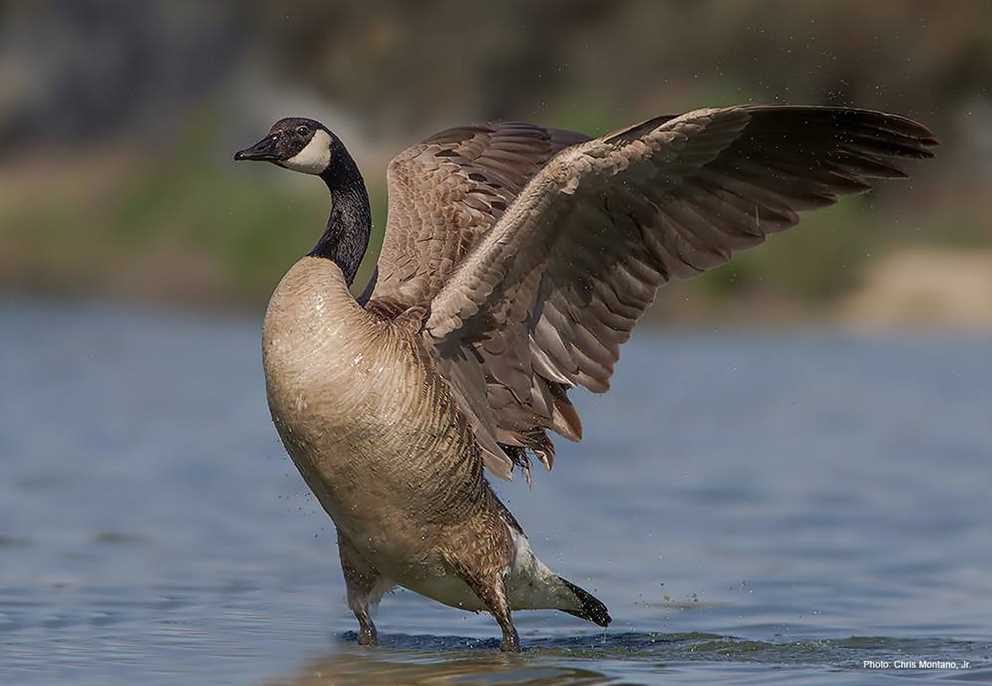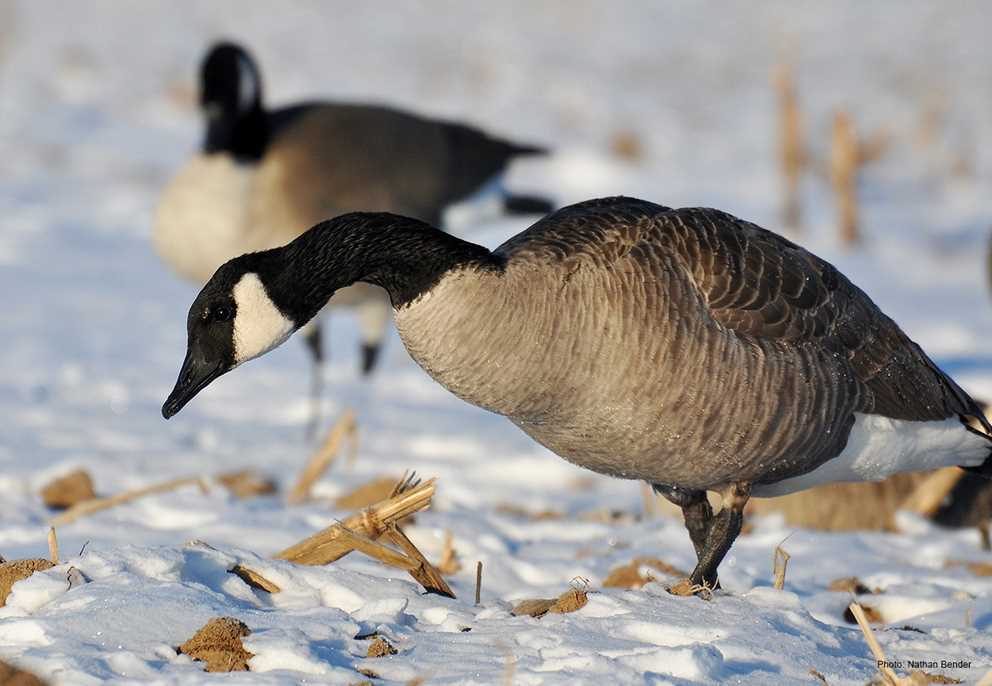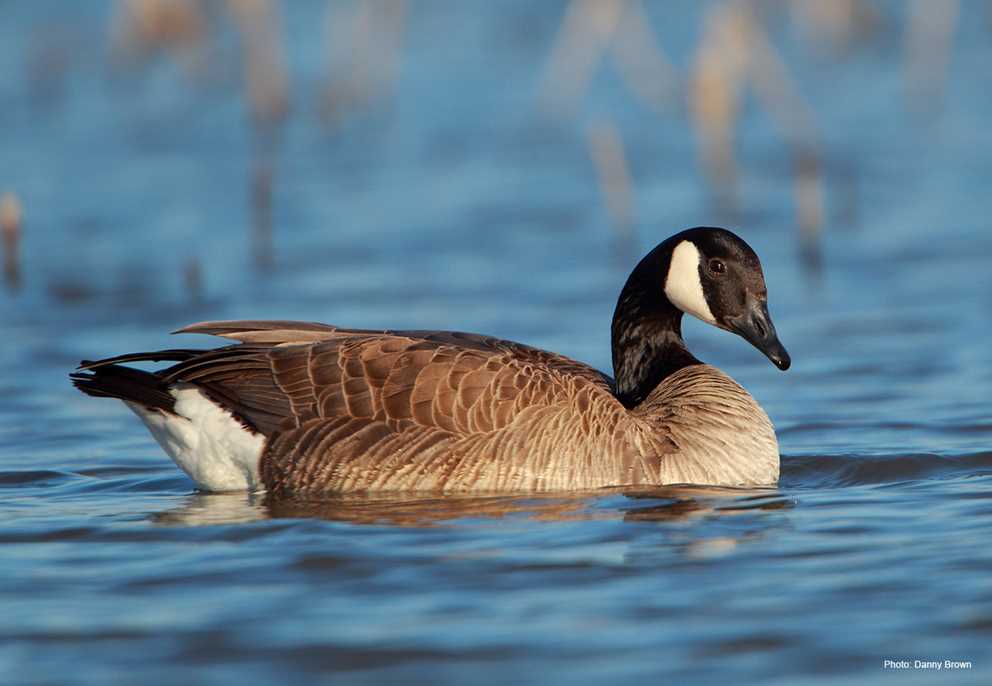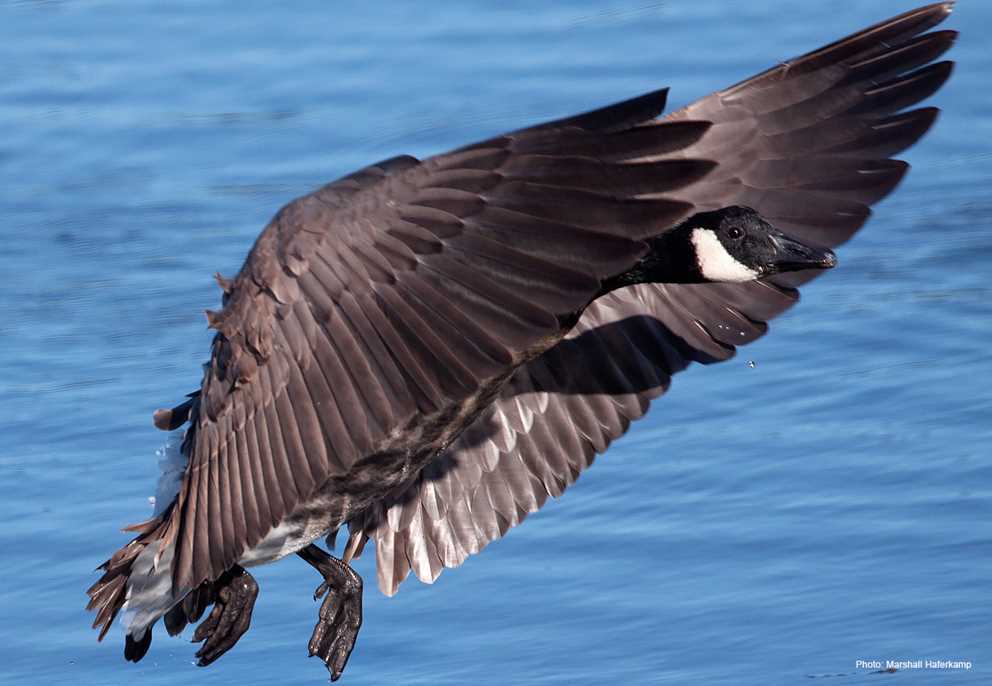Overview
Canada Geese occur widely throughout North America, from the High Arctic to the Gulf of Mexico, the Interior Highlands of Mexico, and from the Atlantic to the Pacific Flyways. In the field, Canada Geese are unmistakable with a black head and neck with a distinctive white chinstrap that extends upward on each cheek to behind their eye. The body plumage is grayish brown, with feathers tipped with light tan, black neck sharply contrasts with the grayish brown breast, the rump is black, upper tail coverts are white, and the tail is black. The breast, belly, sides, and flanks are grayish brown, and the undertail coverts are white. There is subtle to notable variation in size and plumage coloration (lighter to darker coloration) among subspecies. The bill, legs and feet are black. The sexes are identical.
There are seven subspecies that differ primarily in size or breeding/wintering range, with subtle variation in plumage: 1) B. c. moffiti is a mostly resident population that ranges from British Columbia to Manitoba, south and west of the Rocky Mountains to extreme northern California; 2) B. c. maxima was once nearly extinct, but populations are now restored and it has been widely introduced outside of its historic range, which was from southern Manitoba to northern Minnesota south to Kansas, Arkansas, and western Kentucky and Tennessee, now common over much of the South and East due to introductions; 3) B. c. occidentalis, or the Dusky Canada Goose, breeds in southern Alaska, especially the Copper River Delta, and winters in the Lower Columbia River Valley of Washington and Willamette River Valley of Oregon; 4) B. c. fulva that breeds in coastal Glacier Bay, Alaska south to southwestern British Columbia; 5) B. c. parvipes, the Lesser Canada Goose that breeds from boreal central Alaska east to Nunavut, Canada, south to northern British Columbia east to northwestern Hudson Bay, and winters from western Washington south and east to southeastern Colorado, western Oklahoma, south to northern Baja California and Vera Cruz, Mexico; 6) B. c. canadensis that breeds from southern Baffin Island south to eastern Quebec and east to Newfoundland, and winters along the Atlantic coast from Newfoundland and Nova Scotia to New Jersey, and occasionally south to Georgia; 7) B. c. interior that breeds from north central Manitoba east to southern Baffin Island to southwestern Greenland, south to northern Minnesota and Michigan and winters inland for southeastern Minnesota to Pennsylvania south to central Texas and northern Florida.
Given the wide range of the species and the variation among subspecies, Canada Geese use a variety of nesting habitat ranging from Arctic tundra to urban lakes and parks. Winter habitat varies among subspecies, and includes marshes, coastal wetlands, pastures, and extensive use of agricultural fields. Since the early 1980s, some subspecies have shifted their winter range northward as they adapted to use of waste grain in agricultural fields.
Description
Key Identification Features
-
In the field, Canada Geese are unmistakable with a black head and neck with a distinctive white chinstrap that extends upward on each cheek to behind their eye.
- The body plumage is grayish brown with a black neck that sharply contrasts with a grayish brown breast, the rump is blackish, upper tail coverts are white, and the tail is black. The breast, belly, sides, and flanks are grayish brown, and the undertail coverts are white. The bill, legs and feet are black. The sexes are identical.
Male/Female Average Length and Weight
-
Mass: Varies among subspecies; Adults 5.3–19.8 lbs.
- Wing Length: 15.7–21.7 in.
Male and Female Identification
-
Alternate (Breeding) and Basic Plumage: Unmistakable with a black head and neck with a distinctive white chinstrap that extends upward on each cheek to behind their eye. The body plumage is grayish brown, with feathers tipped with light tan, with a black neck that sharply contrasts with a gray-brown breast, the rump is blackish, upper tail coverts are white, and the tail is black. The breast, belly, sides, and flanks are grayish brown with white undertail coverts. There is subtle to notable variation in size and plumage coloration among subspecies, with some showing lighter or darker tones overall. The bill, legs and feet are black. The sexes are identical.
In-flight Identification
- Dusky Canada Geese have broad wings and a dark breast that contrasts highly with white belly.
- Aleutian Geese have a white ring around the lower neck.
- Taverner’s Geese have a lighter breast, narrower wings, and a longer tail.
- Lesser Canada Geese have a wide variety of brownish grey on the breast (darker individuals should be avoided for harvest due to their strong resemblance to Dusky Canada Geese).
- Western Canada Geese have a light, almost white breast, and broad wings.
Vocalizations
- Very vocal, especially in flight and in large flocks. Typical sounds are high to medium pitched “hrooonk” leading to the common nickname of honkers. Smaller subspecies calls tend to be higher pitched than larger subspecies.
Similar Species
- Cackling Geese: Unique in appearance and unlikely to be confused with any other North American species of goose except for the Cackling Goose (formerly a subspecies of Canada Goose). Cackling Geese are much smaller, with shorter necks, smaller bills, and much higher pitched cackling or yelping calls. Note that some smaller subspecies of Canada Geese may be hard to distinguish from Cackling Geese, with the bill size and neck length of Cackling Geese being useful for separation in the field. Canada and Cackling Geese both have distinctive white cheek patches that easily distinguish them from Brant.
Habitat Preferences
- Given the wide range of the species and the variation among subspecies, Canada Geese use a variety of nesting habitat ranging from Arctic tundra, boreal and prairie wetlands, mountain lakes and wetlands to reservoirs, urban lakes, and parks. Likewise, wintering habitat varies among subspecies, and includes marshes, coastal wetlands, pastures, and extensive use of agricultural fields. Since the early 1980s, some subspecies have shifted their winter range northward as they adapted to use of waste grain in agricultural fields.
Foraging Habits and Diet
- Canada Geese are vegetarian and eat a variety of seeds, leaves, berries, roots and rhizomes of numerous grasses, sedges, and some herbaceous plants. In addition, most subspecies have adapted well to foraging for waste grain and winter cereal crops in migration and wintering areas. They feed by grazing, tipping up, grubbing for roots, and picking seeds and waste grain.
Breeding Habits
- Monogamy: Canada Geese maintain monogamous, usually lifelong pair bonds, with birds repairing after death of a mate.
- Nest Locations: The nest is usually a depression created by the female with vegetation and down added as laying progresses.
- Clutch Size: Averages 4 to 6 eggs and varies slightly among subspecies. The eggs are creamy white to tannish white, elliptical to ovoid. Egg size varies with size of subspecies, but roughly 3.3 by 2.2 in. The incubation period is approximately 28 days, with females performing incubation duties. Males provide nest defense.
Migration & Distribution
Some subspecies or subpopulations are resident, others migratory, especially those nesting at far northern latitudes. Timing of migration varies among subspecies. High Artic nesters depart in late August or September for staging areas and usually arrive in wintering areas in October or November. Spring migration may begin in February for some subspecies or subpopulations, with arrivals for High Arctic and other northern latitude subspecies from March to late May or early June. Wintering areas for some subspecies and subpopulations have shifted northward in recent decades (since the 1980s) as birds adapted to use of agricultural habitats, and as winters have warmed.

Conservation Status
- IUCN Status: Least Concern
- Population Status: The global population of Canada Geese is estimated to be between 5,100,000 and 6,200,000, which is probably conservative. Population trends and stability vary among subspecies, with some subspecies not well documented. Many subspecies and subpopulations overlap in winter, and use breeding areas that are not easily surveyed, making it difficult to accurately estimate numbers by subspecies.
- Conservation Concerns: In some areas, certain Canada Goose subspecies have become nuisance birds, such as some populations of Giant Canada Geese. However, the Dusky Canada Goose has undergone a long-term population decline due to habitat loss on its breeding grounds and wintering grounds.
- Conservation Focus: Some populations of Canada Geese are culled to curb overpopulation. For Dusky Canada Geese, there are carefully managed hunting regulations, banding efforts, artificial nest island installation, management of predator populations, and conservation of habitat.
Harvest Information
- An average of 1,853,192 Canada Geese were harvested per season across the US during the 2019 through 2022 hunting seasons.
- Canada Goose harvest is typically highest in the Mississippi Flyway, accounting roughly 40 percent of the total US harvest.
- The top three states for Canada Goose harvest, based on annual averages across the 2019–2022 hunting seasons, were Minnesota (151,525), Michigan (139,900), and Wisconsin (132,696).




